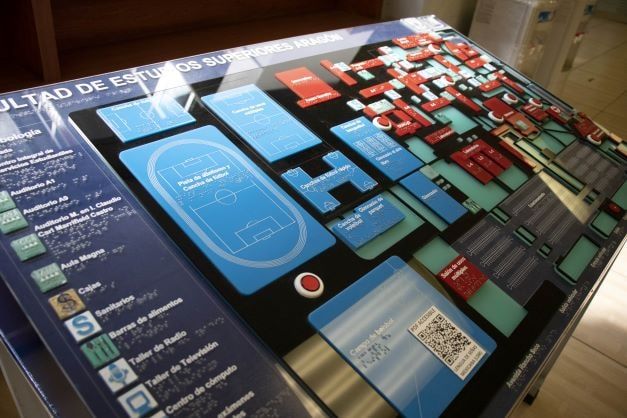Promoting inclusion through textures, buttons and sounds
The academic institution has developed a model that includes a Braille system and makes it easier for people with visual and hearing disabilities to move around the campus.

To promote social inclusion and contribute to the learning of autonomous mobility of the visually and hearing impaired population within the Facultad de Estudios Superiores (FES) Aragón, professors and students, led by Carlos Eduardo Favela Zavala and Arantza Ximena Guerrero Hernández, developed the haptic model of the multidisciplinary unit. This innovation allows them to get to know the facilities through touch with the help of textures, Braille and Mexican Sign Language (LSM).
Professor Carlos Favela, a trained communicologist, explained that the haptic model project (graphic representation with relief) arose from the comments of those attending an English course for the blind and visually impaired. They stated that "they didn't understand how the campus was designed, that it was very large; 'I just feel like you're walking me down a whole huge hallway'." "We detected that, in effect, there were no tools that would allow them to get to know the infrastructure and common areas and thus reduce the obstacles they face in the architectural zones," said Favela Zavala.
In turn, Guerrero Hernandez, a graduate of the Bachelor's Degree in Architecture, indicated that this scale reproduction summarizes the infrastructure of the School, particularly the main buildings: Government, the Technology Center, the Library, the Open, Continuous and Distance University Division where the Language Center is located; the Jose Vasconcelos Theater, the Student Plaza, the Aragon Towers, as well as sports areas and gardens. The entire campus is represented.
The project was elaborated in acrylic, each one of the spaces has its name engraved in Braille and is divided into two sections: on the left side there is a 3D relief symbolism that can be read by touch and also visually. On the right side are the buildings in different colors: red for the classrooms and research areas; blue for the sports areas; black for the corridors and walkways; and green for the planters.
It has a series of buttons that, when pressed, play audio information about the campi, as well as a QR code that, when scanned, generates an accessible PDF document of the areas which, in turn, has the option to enter the LSM interpretation. A sensor was also integrated to remind users to apply antibacterial gel before touching the replica of the multidisciplinary unit. The project is up and running, although some details are still being worked on. Once classroom classes resume, it will be placed in a strategic location for the use of the community and those visitors or new students.

The aim is to attend to diversity, to understand that it is necessary to provide them with information in different ways, according to the needs of each one; this was the main idea that led us to develop this plan, said Carlos Favela. People with disabilities participated in the elaboration of the materials, an important aspect that benefits the blind or deaf population, as well as the community in general.
"Undoubtedly there are things that can be improved based on the experience we have had with some users, but we also understand that this is an important step forward in the development of actions that allow inclusion at UNAM," he said. The prototype was presented on December 3, 2021 in the Chamber of Deputies, on the occasion of the International Day of Persons with Disabilities, and was exhibited in person at the fair El Huateque, organized by the FES Aragón.




